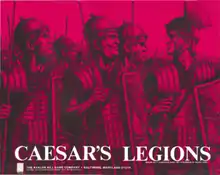Caesar's Legions (board game)
Caesar's Legions is a board wargame published by Avalon Hill in 1975 that simulates various Roman campaigns in Gaul and Germany.

Description
Caesar's Legions is a two-person game in which one player controls Roman Legions mounting incursions beyond the borders of the Roman Empire, and the other player controls opposing Gallic or Germanic tribes.[1]
Components
The game includes:[2]
- 22" x 28"" mounted hex grid map
- 448 die-cut counters
- 16-page rulebook
- 16 Tactical Cards
- various playing aids
Gameplay
Combat is resolved with a die roll that is cross-indexed on a Combat Results Table. However, the use of Tactical Cards may have an effect on the outcome.[3]
Scenarios
The game comes with five historical scenarios:
- Caesar's Conquest of Gaul, 58 BCE
- Caesar's Crossing of the Rhine, 55 BCE
- Teutoburger Wald: Quintillicus Varus walks into a trap, 9 CE
- Idistaviso: Drusus Germanicus attempts to recover the Eagles lost in the Teutoburger Wald, 15 CE
- Batavian Revolt, 68 CE
Publication history
Loren Wiseman designed a game about the Battle of Idistaviso titled Eagles, which was published by Game Designer's Workshop in 1974. The following year, Avalon Hill acquired the rights to Eagles and Don Greenwood expanded the game to include four more scenarios. This expanded game was titled Caesar's Legions, and was published in 1975.[2]
Keith Poulter expanded Caesar's Legions to include 32 scenarios and retitled the game Barbarians: 70 BC - 260 AD. It was published by KP Games in 1994.
In 2010, Camelot Games published an expansion to the original Caesar's Legions designed by Craig Johnson and titled Caesar in Gaul.
Reception
Richard Berg reviewed Eagles, the predecessor of Caesar's Legions, and called it "an interesting failure" that "has no playability to speak of." Berg chiefly objected to the game mechanics that allowed the German chieftains to avoid combat by hiding in the forest; if discovered by the Romans, they could simply flee to a different part of the forest. Berg did admit that the production values of the game were "heads above most" with "excellent clear graphics and well made counters [...] signs of the care and preparation put into this game." But he concluded with a thumbs down, saying, "Eagles is less of an eagle and more of a turkey."[1]
In his 1977 book The Comprehensive Guide to Board Wargaming, Nicholas Palmer acknowledged that the first two scenarios of Caesar's Legions were easy enough to allow new players to learn the rules, but "Unfortunately the early scenarios are too simple for most tastes, and unbalanced in favour of the Romans. The later [scenarios], however, are absorbing and varied." He warned that "German play is always tricky, involving hit-and-run guerilla tactics." Palmer concluded that "it should appeal to anyone interested in the period, even if the Latin names are a trifle distorted at times!"[3]
Other reviews and commentary
- Fire & Movement #22
- The Wargamer Vol.1 #1
- Panzerfaust & Campaign #72
References
- Berg, Richard (June–July 1974). "Forward Observer". Moves. No. 15. p. 26.
- "Caesar's Legions (1975)". boardgamegeek.com. Retrieved 2022-04-19.
- Palmer, Nicholas (1977). The Comprehensive Guide to Board Wargaming. London: Sphere Books. p. 139.